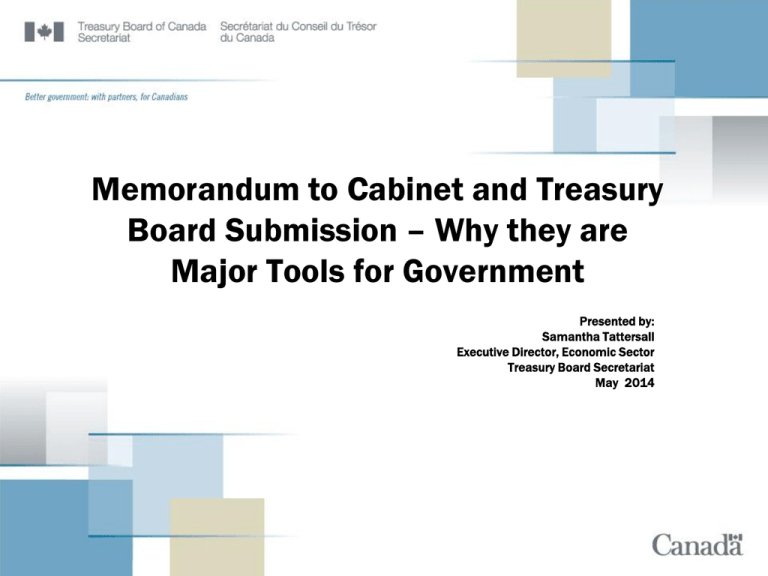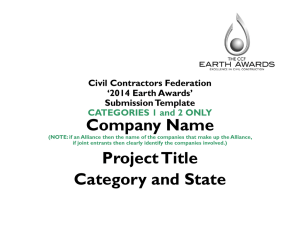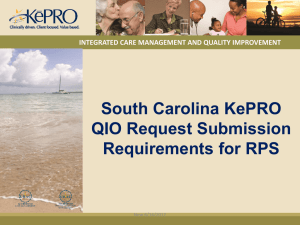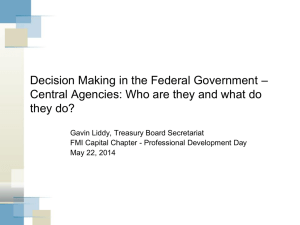
Memorandum to Cabinet and Treasury
Board Submission – Why they are
Major Tools for Government
Presented by:
Samantha Tattersall
Executive Director, Economic Sector
Treasury Board Secretariat
May 2014
Overview
To provide an understanding of the decision making process in
the Federal Government:
•
The Role of Memorandum to Cabinet and TB Submissions, –
including differences between them
•
The new TB Submission template and guidance:
Key considerations while drafting
The process to get to a TB Meeting
Tips for Success
2
Decision making process
Three of the key approvals typically needed to put in place a
new initiative/program:
• Funding approval:
Typically happens through the Budget process (unless there is
an “off Budget decision”)
Finance Canada leads the process - new advisory role for TBS
• Policy approval:
Memorandum to Cabinet
PCO leads the process but both Finance and TBS involved
• Program approval:
Treasury Board Submission
Treasury Board Secretariat leads the process
3
How a Federal Organization Gets Funding for
a New Initiative
Cabinet Approval
(MC)
Minister seeks Cabinet
approval of a policy or
new initiative through
an MC which explains
the new initiative and
proposes options.
If approved, Minister
now has policy
authority, but Minister
still cannot proceed –
Minister needs
program approval as
well ( e.g. “terms and
conditions”)
MC’s approve an idea
Treasury Board
Approval (TB
Submission)
Once Minister has policy
authority AND a source of
funds, Minister seeks
program authority from TB
through a TB Submission.
In this Submission,
Minister provides concrete
details on program
objectives, outcomes,
detailed delivery model,
outcomes, value for
money, and all applicable
TB policies.
Parliamentary
Approval
(Actual $$ Flow
to Organization)
TB Submissions are far
more detailed than MCs
Once approved by TB,
organization has
authority to proceed,
but the funding cannot
flow to an organization
until Parliament grants
its approval of the
Estimates by passing
the related
Appropriation Bill (i.e.,
Main Estimates and
Supplementary
Estimates). Many
departments `’risk
manage`’ this process.
TB Subs approve detailed
program parameters.
Parliament approves
expenditure authority.
4
Cabinet Approval
Memorandum to Cabinet (MC)
•
The MC’s main purpose is to seek approval of a new initiative. Often referred to as
“policy approval”, Cabinet approval generally gives a government organization
permission to continue to explore the possibility of implementing a “new idea”.
•
MCs can be written for several different reasons, including when:
A federal organization proposes a new program or policy that is consistent with the
government’s priorities, such as initiatives that stem from the Speech from the
Throne;
An organization requires additional funds in order to meet legislative or regulatory
requirements;
New issues arise that demand action by an organization on behalf of the
government; or;
The Prime Minister or a Minister wishes to bring forward a new policy or to respond
to a past Cabinet commitment outside of the Budget.
As the MC occurs earlier in the overall process, the level of information included in
an MC is sometimes of a more general nature with a focus on the policy rationale
(`why do we need this’?)
Detailed information about the delivery of a new initiative is provided later to Treasury
Board through a TB Submission when the organization has a business case that
outlines program design and an implementation plan (‘how are we going to do this?’).
5
Treasury Board Approval
TB Submission
•
The TB Submission’s main purpose is to seek program authority from Treasury
Board ministers to carry out a new initiative which has already received Cabinet
approval and a source of funds
•
TB Submissions can also be written for different reasons, including when an
organization requires:
authority to carry out a project or initiative, the costs of which would exceed a minister's
delegated authority;
authority to make grants or contributions, or approval of amendments to terms and
conditions of grant and contribution programs;
recommendations of approval of orders in council with resource or management
implications;
authority to enter into a contract above or outside a federal organization's or minister's
authority; or
an exemption from a Treasury Board policy.
A Submission is an official document submitted by a sponsoring minister on
behalf of a federal organization seeking approval or authority from the Treasury
Board for an initiative that the organization would not otherwise be able to
undertake or that is outside its delegated authorities.
6
MCs and TB Submissions inform Government
decision-making by different means
Memorandum to Cabinet
Purpose
To seek approval of a policy or new initiative
TB Submission
To seek approval of elements for a program's
design, delivery and implementation
Detailed program design and implementation
Policy rationale, with a clear outline of policy plan; detailed costing; results measurement
Focus
objectives; proposal for implementation
and accountability frameworks; opportunities
for reallocation.
General funding information, with total
Specific funding details and a clear rationale
amount of resources by year which includes
for what resources will be spent each year,
Resource details
implementation costs (cash and accrual
including specific FTEs
basis)
Policy Committees, Cabinet ministers
Treasury Board Ministers (presented by TBS
Target audience
(presented by sponsoring Minister(s))
Program Sector Assistant Secretary)
Organization(s) sponsoring the submission (in
Key federal
Organization(s) sponsoring the MC, PCO,
the case of a Crown corporation, the
Finance, TBS and other interested federal
organizations
corporation itself and the portfolio department)
organizations
involved
and TBS
Ministerial Recommendation (MR) approved,
TBS prepares recommendations, TB makes
approved-in-principle, postponed or not
Recommendation/
the final decision to approve, approve with
approved by policy committee. Approval
conditions or defer (can differ from TBS
Approval
must be ratified by Cabinet or Priorities and
recommendations)
Planning
7
Crosswalk Between Cabinet
Documents
The MC and TB Submission templates include the following
information:
Memorandum to Cabinet
Treasury Board Submission
Ministerial Recommendations
Issue
Recommendations
Rationale
Proposed Approach and Options
Considerations
Due Diligence
Title and Synopsis
Authorities Sought from the Treasury Board
Background
Rationale
Expected Outcomes
Risks and Risk Responses
Cost and Source of Funds
Costing Due Diligence and Validation
Contact
Annexes
Appendices
Annex X to the MR: Implementation Plan
Appendix A: Financial appendices
Appendix B: Existing Statutory and Policy
Authorities
Appendix C: Program Alignment and
Performance Measurement
Appendix D: Audit and Evaluation
Appendix E: Government-Wide Policy
Consideration (Environmental concerns,
Gender-Based Analysis, Official
Languages)
Annex Y to the MR: Strategic
Communications Plan
Annex Z to the MR: Parliamentary Plan
8
New Treasury Board Template
- Modernizing to Meet Government Priorities Information is presented in a way that tells a more coherent, easy to
follow story about proposals contained in a submission
•
•
•
•
•
•
•
•
•
•
Title and Synopsis
Authority Sought from TB
Background
Rationale
Design, Delivery and
Implementation*
Expected Outcomes *
Risk(s) and Risk Responses *
Cost, Funding Requirements and
Source of Funds *
Costing Due Diligence and
Validation*
Contact
* New headers or sections
9
New Treasury Board Template
- Modernizing to Meet Government Priorities Old Form
Section Title
Subject
Authority
Proposal
Cost and Source of Funds
Official Languages
Audit and Evaluation
Remarks
Departmental Contact
* New Section
New Form
Section Title
Title and Synopsis
Existing Statutory and Policy Authorities
Authorities Sought from the Treasury Board
Cost and Source of Funds
Mandatory Appendices (OL, GBA and
Environmental Concerns)
Audit and Evaluation Appendices
Background*
Rationale*
Expected Outcomes*
Risks and Risk Responses*
Costing Due Diligence and Validation*
Program Alignment and Performance
Measurement Appendices*
Contact
Location on New Form
Body of Submission
Appendices
Body of Submission
Body of Submission
Appendices
Appendices
Body of Submission
Appendices
Body of Submission
10
Key Considerations for Drafting TB
Submissions
•
•
•
•
The new TB Submission template helps provide a clearer and more
coherent story to explain the proposed initiative to Ministers
New series of practical questions that each organization should take
into consideration when drafting TB Submissions
The questions are reflective of current TB Minister interests, and can
change over time as priorities change
Key Consideration Guidance is aligned per section of new template:
Authorities Sought From the Treasury Board
Background
Rationale
Expected Outcomes
Risks and Risk Responses
Cost and Source of Funds
Costing Due Diligence and Validation
11
http://www.tbs-sct.gc.ca/tbs-pct/dgw-ddir/tps-opp-eng.asp
12
Key Considerations Excerpt :
Background
• What is the context for your proposal?
• How is the proposal linked to your organization’s mandate?
• What is the history of the proposal or program? How long has it
existed? What has its budget been historically?
• Have there been any previous Cabinet or Treasury Board
decisions related to the proposal?
• Have there been any relevant public announcements related to
the proposal?
13
Key Considerations Excerpt :
Rationale
•
Why is the proposed course of action needed? What problem is being
solved by the authorities that are being sought?
How does the proposal support or link to government priorities?
Is this a legitimate and necessary role for the federal government?
•
What is the relevant policy and expenditure context?
Is this a new initiative, or the renewal of an existing program? What were
the previous results achieved?
Was the proposed course of action developed as a result of a gap analysis?
What comparative benchmarks have been used to gauge the
reasonableness of this proposal?
•
How does the proposal align with your organization’s existing programs
and program activity architecture (PAA)?
Has your organization demonstrated a clear gap in its suite of programs and
policies or in the relevant PAA s of other government organizations, for
horizontal activities?
14
Key Considerations Excerpt :
Expected Outcomes
• What are the expected outcomes?
• How will you measure success?
• Do your outcomes align with your organizational mandate?
• Are your delivery strategies aligned with your policy objectives?
• What are your plans for audit and evaluation?
15
Key Considerations Excerpt :
Risks and Risk Responses
• How complex is your proposal?
• Does your organization have the capacity to deliver the
initiative?
• Does the history of the issue indicate any risks?
• What are the financial risks?
• How will your organization respond to and monitor risks?
16
Key Considerations Excerpt :
Cost and Source of Funds
• Has your organization considered every aspect of
each proposal’s cost and source of funds?
Have you examined cheaper delivery alternatives?
Have you explored cost-recovery options?
Is there a risk of costs exceeding estimates that could lead to
unfunded costs and program integrity concerns in the future?
17
Key Considerations Excerpt :
Costing Due Diligence and Validation
•
How do costs align with the government’s priority to reduce spending?
Is this proposal related to previous DRAP or SR decisions? Does it recreate
previously cut or reduced programs?
What efforts were made to keep costs down?
Is it affordable in the current fiscal context?
•
How are costs contained?
Are the requested financial resources adequate to deliver the program?
Is there sufficient rationale for ongoing resources?
What efforts has your organization made to minimize operating costs?
•
Has your organization demonstrated due diligence?
Is the methodology that was used to prepare the cost estimates in line with
the TB Guide to Costing?
Are there comparable national or international initiatives?
18
Key players in the process of Drafting
a TB Submission
•
In your client department:
•
Program area(s) originating the submission
Departmental corporate / finance group
Other key branches in in your department (legal, audit, evaluation etc)
Deputy Minister
Minister
At Treasury Board Secretariat:
Program Sector analyst assigned to client department – primary point
of entry
Policy centre analyst(s) – experts in subject areas
Assistant Secretaries who will present to Treasury Board
19
19
TB Submission Approval Process:
90% lies below the surface
20
The Tip of the Iceberg
Draft
submission
Department
TBS Analyst
Comments
New Service Standards - within 5 working days of receiving a draft TB
submission, the Secretariat will assess the overall quality. Within 10
working days of confirming that the due diligence review will proceed, the
Secretariat will provide substantive comments on the draft TB
submission.
21
TB Submission Process
Draft
Department
submission
(through Corporate
Services – Finance)
Draft submission
TBS Analyst
Policy Areas
Final draft of submission
Submitted to TBS
Analyst Reviews
Draft
Précis drafted by analyst
New Draft
Prepared
Analyst shares
comments with Dept.
The collaboration between departments and TBS will
continue until the TBS analyst has ensured that all
issues involving the submission are addressed. This
step will determine the length of time required to
approve the submission.
22
TB Submission Process
Final Precis
Final Signed
Submission due to
TBS
3.5 wks prior
to TB
Assistant Secretary
Reviews Submission and
Précis with Analyst
2 wks prior
to TB
Secretary Reviews
Submissions and Précis
with other Assistant
Secretaries and the
Secretary of TB
1.5 wks prior
to TB
President’s
Briefing
23
What happens at the Meeting ?
• TBS officials brief TB Ministers
• Ministers have four options for decisions:
Approve as proposed
Approve with conditions
Not approve
Defer decision
24
24
Tips for Success
• Engage early and regularly with TBS:
Regular meetings forge a strong working relationship
Engagement helps identify issues early on so we can work
towards solutions
Ongoing communications during the process is essential for
effective management of departmental business
• A long submission is not necessarily a good submission –
always ask, what is the storyline?
• Remember the audience (TB Ministers)
Don’t focus on technical details (or use language that is overly
technical), be strategic about what information to include
Anticipate what questions TB Ministers may have
• Expect the process to take approximately 3 months (if not
more) & plan accordingly
25
• Your TBS analyst will both challenge and defend your case;
help us, help you – by providing information in a timely way
25
Questions
Samantha.tattersall@tbs-sct.gc.ca
26






